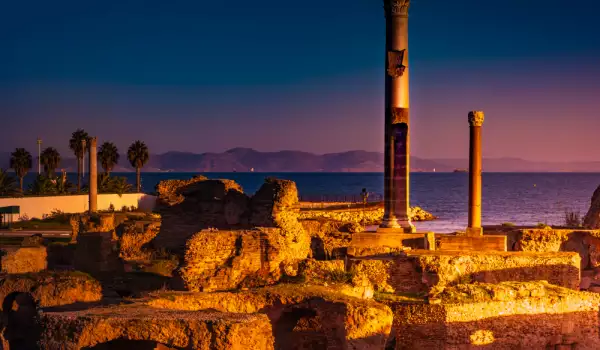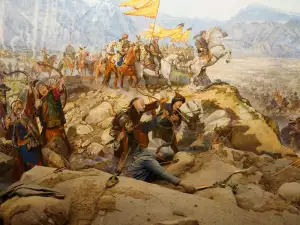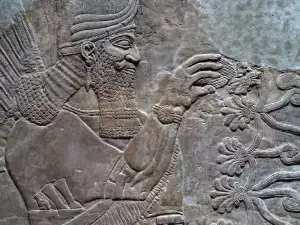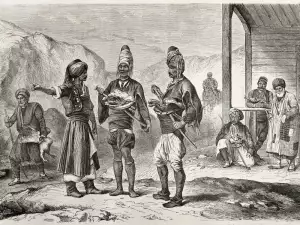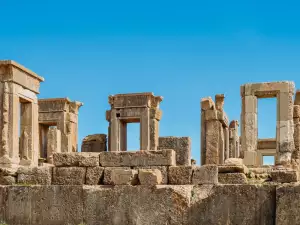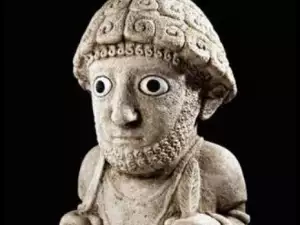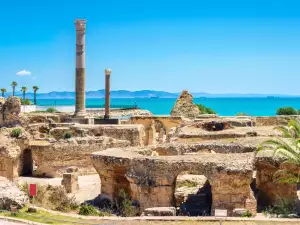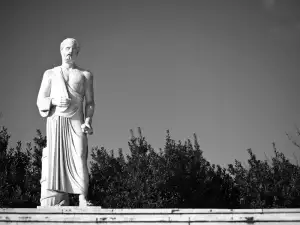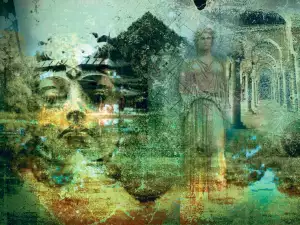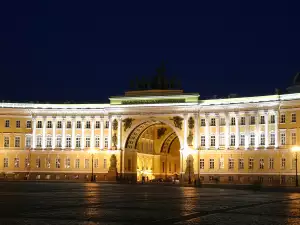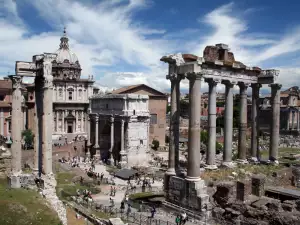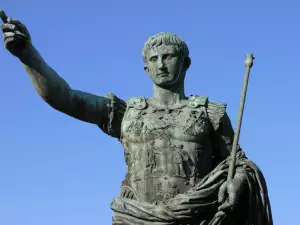According to legend Carthage was founded by the Phoenician queen Elisa (better known as Dido) sometime around 813 BC, although in fact the great city was built after the destruction of Tyre by Alexander in 332 BC.
The city (located in modern Tunisia, North Africa) was originally known as Kart-hadasht (new city) to distinguish it from the older Phoenician city of Utica located nearby. The Greeks called the city Carcedon and the Romans transformed this name into Carthage.
Originally Carthage was a small port on the coast, created only as a stopover for Phoenician merchants to reload or repair ships. Over the years, however, it became the most powerful and wealthy city in the Mediterranean before the rise of ancient Rome.
After the fall of the great Phoenician city of Tyre to the invincible army of Alexander the Great in 332 BC, many of its inhabitants managed to escape to Carthage. Many of the wealthy families of the city bought their lives and property from the Macedonians and moved with a large part of their property to Carthage, turning it into a new center of Phoenician trade.
It was then that the foundations of the Carthaginian Empire were laid. The Carthaginians subjugated the native Africans in the area of present-day Tunisia and made the other kingdoms in North Africa vassal. Over time, they established friendly relations with the tribes of neighboring Numidia, who filled the ranks of the Carthaginian army with formidable cavalry troops.
Carthage is growing larger and grander with vast estates covering miles of its center. Less than a hundred years after these events, Carthage became the richest city in the Mediterranean. Aristocrats live in huge palaces, but merchants also have rich mansions, not inferior to them in size and splendor.
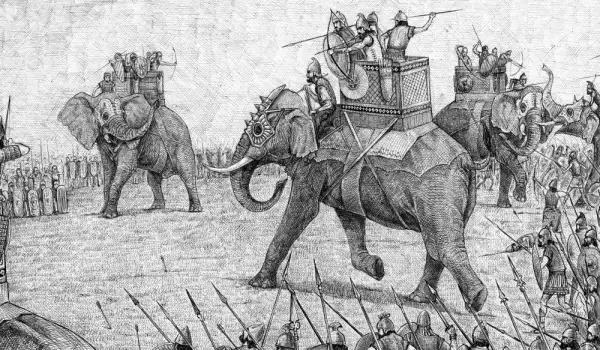
The city's harbor is huge, with 220 docks, glittering columns that rise around it in a semicircle and decorated with Greek sculptures. Carthaginian merchant ships sail daily throughout the Mediterranean, while their navy, the strongest of its time, guards them. The Sea Empire greatly expanded its influence through trade and conquest of nations that did not want to trade with it.
This way, Carthage gradually became the center of a vast state, covering most of present-day Spain, the Balearic Islands, Corsica, Sardinia, Sicily, the territories of present-day Morocco, Algeria, Tunisia and most of off the coast of present-day Sicily. Its influence extended even further.
Everyone had to comform to them erchants coming from the city. They had special privileges that other peoples did not have.
In their quest to open new markets, the Carthaginian sailors reached places that would not become known to the rest of the Mediterranean people for the next ten centuries. They reached Britain, some went around Africa and even according to some little-known theories they managed to cross the Atlantic and reach the shores of Brazil.
It was this expansion that brought Carthage into conflict with Rome. At the beginning the Roman Republic was significantly weaker than Carthage and posed no threat. The power and reputation of the Carthaginian navy was enough to frighten the Romans into forcing a treaty that cut Rome off from trade in the western Mediterranean. Although this situation was disadvantageous for the Roman Senate, they had to endure it.
The moment Carthage invaded Sicily, Rome decided to respond. Although it has no navy and knows nothing of warfare at sea, the Republic builds a fleet of 330 ships, which it equips with smart ramps and passages (corvus) that can descend on and gain access to an enemy ship, turning naval combat into terrestrial.
This way the First Punic War (264-241 BC) began. After initially struggling with military tactics, Rome won a series of victories and finally defeated Carthage in 241 BC. Carthage was forced to cede Sicily to Rome and pay a heavy military indemnity.
The Phoenician city lost some territories, but the main loss was its prestige. The dire financial situation in which the trading empire falls leads to the outbreak of another war. It became known as the Mercenary War (241-237 BC). While the Roman legions were filled by the local population, who defended the interests of their state, the Carthaginian army was composed mainly of mercenaries. After defeat in the first Punic War, the Carthaginian aristocracy failed to pay the mercenaries and they went to war to get what was owed to them.
The fighting continued for four years, during which many of Carthage's wealthy provinces were ruined. In the end, the Carthaginian general Hamilcar Barca managed to defeat the mercenaries.
Carthage suffered greatly from these conflicts and when Rome occupied the Carthaginians, the colonies of Sardinia and Corsica, he could do nothing to prevent the loss of his valuable provinces.
The Carthaginian aristocracy tried to consolidate the shaky state of the country, by conquering and expanding their holdings in Spain. The armies, led by the greatest general of his time Hannibal, overran vast parts of the Iberian Peninsula. However, this led to another conflict with Rome when the Carthaginians conquered the Spanish city of Sagunt, an ally of Rome.
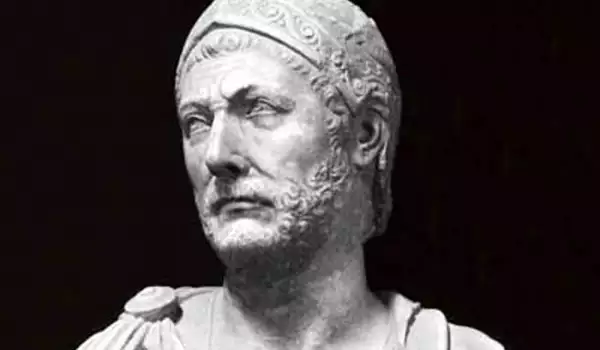
This marked the beginning of the Second Punic War (218-202 BC), which was fought mainly in northern Italy. Hannibal invaded from Spain, marching his troops across the Alps.
Hannibal wins every battle against the Romans in Italy. In 216 BC he won his greatest victory at the Battle of Cannae, but without sufficient soldiers and supplies he was unable to gain anything substantial from his victories. The great general was defeated by the Roman general Scipio at the battle of Zama, in North Africa, in 202 BC. The defeat was so severe that Carthage was again forced to beg for peace.
Carthage loses all its overseas territories. The Romans left them only territories in a small part of North Africa (today's northern and central Tunisia). They were also ordered to pay a huge monetary compensation and forbidden to maintain an army.
Placed in such dire situation, Carthage must at the same time fend off constant raids by the Numidian king Masinissa (Rome's ally in the Second Punic War). These raids were instigated by Rome.
To defend its territory, Carthage raised an army and went to war with the Numidians, thereby violating the peace treaty with Rome that forbade the city from mobilizing an army. As a result, the Senate forced the Carthaginians to disband their army and pay a new military debt to Numidia. Rome was not interested in the conflict between the two African states, but was afraid of the sudden revival of the Carthaginian army.
The famous Roman senator Cato the Elder, one of the most influential figures of his time, campaigned for the final destruction of Carthage. For this goal, he ends all his speeches, regardless of what he is talking about, with the words: Furthermore, I think that Carthage must be destroyed.
In 149 BC Rome undertook exactly this strategy. The Roman embassy in Carthage conveys to the rulers of the city the absurd condition of the Senate that Carthage should be literally dismantled and rebuilt inland. The Carthaginians, of course, refused and this led to another, Third and last Punic War (149-146 BC).
However, Carthage's military might is now in the past. The Roman general Scipio Aemilianus laid siege to the city. The siege lasted three years. Eventually its walls are breached and the Romans invade.
Scipio, who after this victory began to be called Africanus, ordered Carthage to be destroyed. Chronicles say that he wept as he issued this order.
Not a stone is left on a stone of the city. Its inhabitants were sold into slavery and the land on which it stood was sprinkled with salt. This puts an end to one of the greatest ancient cities.
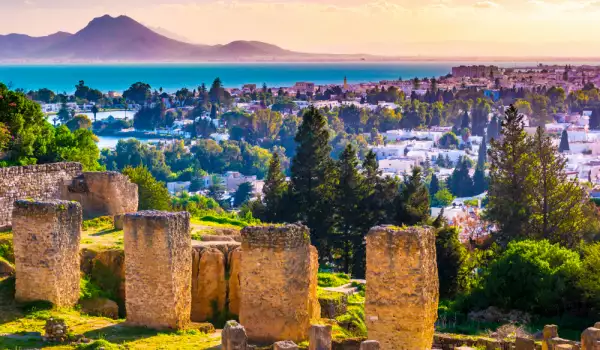
However, the fame of the city, even after its destruction, did not fade. In 122 BC, it was rebuilt, but now as Roman Carthage and according to the Roman urban planning model. Carthage was also the first Roman colony outside the Italian peninsula. Gradually its former glory was restored and the Roman city became the fourth most important in the Roman Empire after Rome, Alexandria and Antioch, becoming the capital of the first non-European Roman province - Africa.
During the Great Migration in the 5th century, Carthage was briefly the capital of the Vandal kingdom. In the year 533 during the reign of Emperor Justinian I, the Byzantine army, led by the famous general Belisarius, recaptured the city for the empire, reintegrating it into the Byzantine sphere of influence.
At the very end of the 7th century, during the Arab expansion in North Africa, the city was captured and turned into ruins, at the expense of the rise of Tunisia. Throughout the Middle Ages, the once glorious first opponent of Ancient Rome - ancient Carthage - was in ruins.
It is still the same today, but with the difference that the city is the biggest tourist attraction and source of income in the Republic of Tunisia. The outline of the great harbor can still be seen, as well as the ruins of homes and palaces from when the city of Carthage ruled the Mediterranean.
